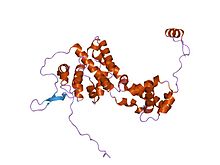
An RNA virus is a virus characterized by a ribonucleic acid (RNA) based genome. The genome can be single-stranded RNA (ssRNA) or double-stranded (dsRNA). Notable human diseases caused by RNA viruses include influenza, SARS, MERS, COVID-19, Dengue virus, hepatitis C, hepatitis E, West Nile fever, Ebola virus disease, rabies, polio, mumps, and measles.
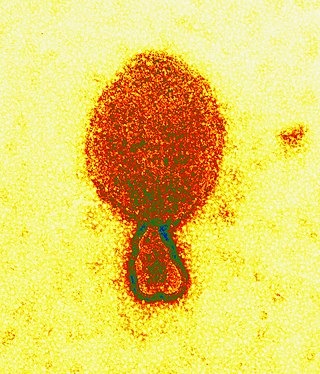
Henipavirus is a genus of negative-strand RNA viruses in the family Paramyxoviridae, order Mononegavirales containing six established species, and numerous others still under study. Henipaviruses are naturally harboured by several species of small mammals, notably pteropid fruit bats, microbats of several species, and shrews. Henipaviruses are characterised by long genomes and a wide host range. Their recent emergence as zoonotic pathogens capable of causing illness and death in domestic animals and humans is a cause of concern.

Mononegavirales is an order of negative-strand RNA viruses which have nonsegmented genomes. Some members that cause human disease in this order include Ebola virus, human respiratory syncytial virus, measles virus, mumps virus, Nipah virus, and rabies virus. Important pathogens of nonhuman animals and plants are also in the group. The order includes eleven virus families: Artoviridae, Bornaviridae, Filoviridae, Lispiviridae, Mymonaviridae, Nyamiviridae, Paramyxoviridae, Pneumoviridae, Rhabdoviridae, Sunviridae, and Xinmoviridae.
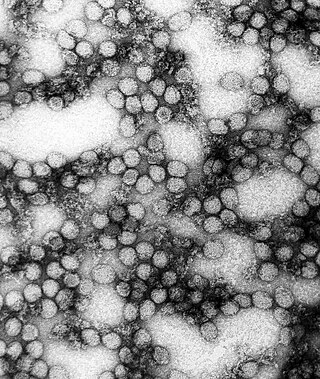
Flavivirus, renamed Orthoflavivirus in 2023, is a genus of positive-strand RNA viruses in the family Flaviviridae. The genus includes the West Nile virus, dengue virus, tick-borne encephalitis virus, yellow fever virus, Zika virus and several other viruses which may cause encephalitis, as well as insect-specific flaviviruses (ISFs) such as cell fusing agent virus (CFAV), Palm Creek virus (PCV), and Parramatta River virus (PaRV). While dual-host flaviviruses can infect vertebrates as well as arthropods, insect-specific flaviviruses are restricted to their competent arthropods. The means by which flaviviruses establish persistent infection in their competent vectors and cause disease in humans depends upon several virus-host interactions, including the intricate interplay between flavivirus-encoded immune antagonists and the host antiviral innate immune effector molecules.
Borna disease, also known as sad horse disease, is an infectious neurological syndrome of warm-blooded animals, caused by Borna disease viruses 1 and 2 (BoDV-1/2). BoDV-1/2 are neurotropic viruses of the species Mammalian 1 orthobornavirus, and members of the Bornaviridae family within the Mononegavirales order.
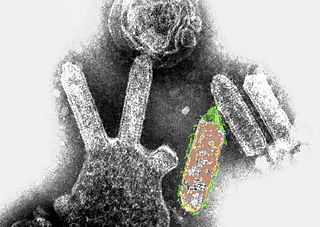
Lyssavirus is a genus of RNA viruses in the family Rhabdoviridae, order Mononegavirales. Mammals, including humans, can serve as natural hosts. The genus Lyssavirus includes the causative agent of rabies.

Vesiculovirus is a genus of negative-sense single-stranded RNA viruses in the family Rhabdoviridae, within the order Mononegavirales.
Proventricular dilatation disease (PDD) is an incurable probably viral disease of psittacine birds. It was first recognized and described in 1978 by Dr. Hannis L. Stoddard. Since the first reported cases were involving species of macaw, the condition was termed macaw wasting syndrome.
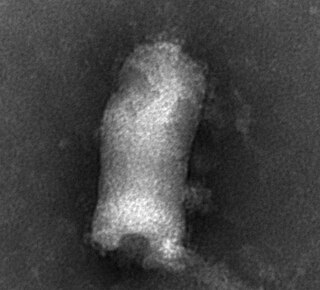
Novirhabdovirus is a genus of the family Rhabdoviridae containing viruses known to infect aquatic hosts. They can be transmitted from fish to fish or by waterborne virus, as well as through contaminated eggs. Replication and thermal inactivation temperatures are generally lower than for other rhabdoviruses, given the cold-blooded nature of their hosts. Hosts include a large and growing range of marine and freshwater fish.

The variegated squirrel is a tree squirrel in the genus Sciurus found in Costa Rica, El Salvador, Guatemala, Honduras, southern Mexico, Nicaragua, and Panama. Fifteen subspecies are recognised. It is a common squirrel and the International Union for Conservation of Nature has rated it a "least-concern species". Variegated squirrels kept as pets in Germany have been implicated in the transmission of a bornavirus to humans from which three people have died.
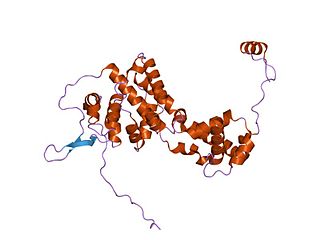
The Borna disease viruses 1 and 2 are members of the species Mammalian 1 orthobornavirus and cause Borna disease in mammals.
In 2008, by pyrosequencing of cDNA from the brains of several parrots suffering from proventricular dilatation disease (PDD), Honkavuori et al. identified the presence of a novel bornavirus.

Nyamiviridae is a family of negative-strand RNA viruses in the order Mononegavirales. Ecdysozoa and birds serve as natural hosts. The name is a portmanteau of Nyamanini Pan and Midway Atoll and the suffix -viridae used to denote a virus family. There are seven genera in this family.
Ferlavirus, also referred to as Ophidian paramyxovirus, is a genus of viruses in the family Paramyxoviridae, order Mononegavirales. Reptiles serve as natural hosts. There is currently only one species in this genus to accommodate a single virus, Fer-de-Lance virus (FDLV).
Perhabdovirus is a genus of viruses in the family Rhabdoviridae, order Mononegavirales. Fish serve as natural hosts. Diseases associated with viruses of this genus include: breathing and swimming problems.
Sprivivirus is a genus of viruses in the family Rhabdoviridae, order Mononegavirales. Fish serve as natural hosts.
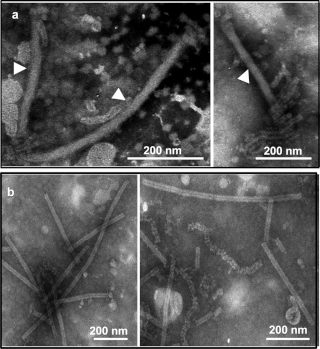
Mymonaviridae is a family of negative-strand RNA viruses in the order Mononegavirales, which infect fungi. Fungi serve as natural hosts. The name is a portmanteau of Ancient Greek myco, which means fungus, and mononegavirales. This family was established to accommodate Sclerotinia sclerotiorum negative-stranded RNA virus 1 (SsNSRV-1) a novel virus discovered in a hypovirulent strain of Sclerotinia sclerotiorum.

Pneumoviridae is a family of negative-strand RNA viruses in the order Mononegavirales. Humans, cattle, and rodents serve as natural hosts. Respiratory tract infections are associated with member viruses such as human respiratory syncytial virus. There are five species in the family which are divided between the genera Metapneumovirus and Orthopneumovirus. The family used to be considered as a sub-family of Paramyxoviridae, but has been reclassified as of 2016.

The genus Orthopneumovirus consists of pathogens that target the upper respiratory tract within their specific hosts. Every orthopneumovirus is characterized as host-specific, and has a range of diseases involved with respiratory illness. Orthopneumoviruses can cause diseases that range from a less-severe upper-respiratory illness to severe bronchiolitis or pneumonia. Orthopneumoviruses are found among sheep, cows, and most importantly humans. In humans, the orthopneumovirus that specifically impacts infants and small children is known as human respiratory syncytial virus.
Cruliviridae is a family of virus in the order of Bunyavirales. Unlike other families in the order, this family is unique in the sense that it is only used to contain crustacean-infecting bunyaviruses.
